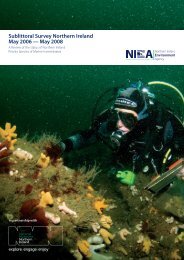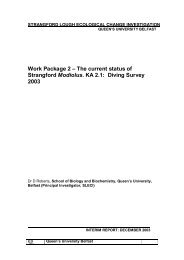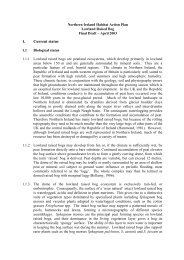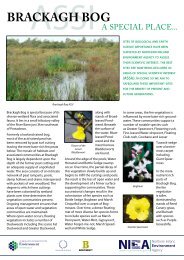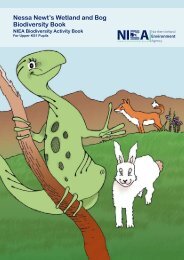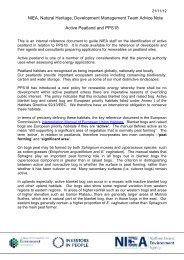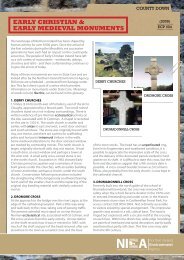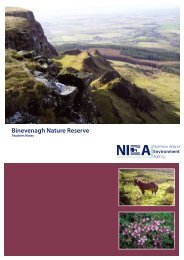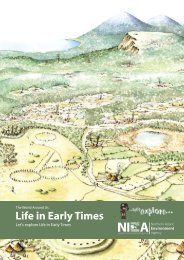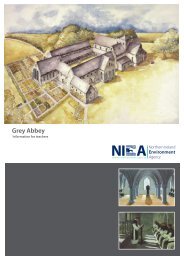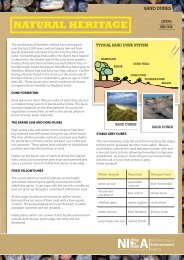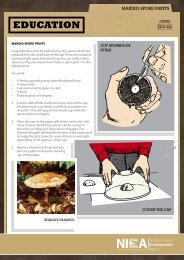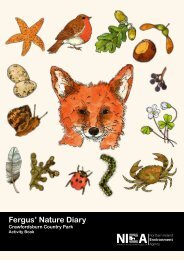All Ireland Species Action Plan - Killarney Fern - Department of the ...
All Ireland Species Action Plan - Killarney Fern - Department of the ...
All Ireland Species Action Plan - Killarney Fern - Department of the ...
Create successful ePaper yourself
Turn your PDF publications into a flip-book with our unique Google optimized e-Paper software.
Environment & Heritage Service<br />
ALL IRELAND SPECIES ACTION PLAN –<br />
<strong>Killarney</strong> <strong>Fern</strong> Trichomanes speciosum<br />
March 2007
1 Current status<br />
<strong>All</strong>-<strong>Ireland</strong> <strong>Species</strong> <strong>Action</strong> <strong>Plan</strong><br />
<strong>Killarney</strong> <strong>Fern</strong> Trichomanes speciosum<br />
February 2007<br />
1.1 Trichomanes speciosum Willd. (<strong>Killarney</strong> <strong>Fern</strong>; Raithneach Chill Airne) is a member<br />
<strong>of</strong> <strong>the</strong> family Hymenophyllaceae (Filmy ferns). It is a distinctive, long-lived fern with<br />
dark-green, translucent pinnately divided fronds (leaves) which arise from a creeping<br />
rhizome. The leaves can be up to 450mm in length (Stace, 1997). They are<br />
particularly sensitive to dessication and are not adapted to reduce or control water loss<br />
(Rumsey, 1994). T. speciosum has a 2-stage life cycle. The typical fern-like stage is<br />
known as <strong>the</strong> sporophyte, while <strong>the</strong> o<strong>the</strong>r stage is <strong>the</strong> perennial filamentous<br />
gametophyte which is capable <strong>of</strong> reproducing asexually by means <strong>of</strong> gemmae (Vogel<br />
et al., 1993). In <strong>Ireland</strong> <strong>the</strong> sporophyte occurs in dripping caves, cliff faces, crevices<br />
by waterfalls and cascades, rock crevices in woodlands and very occasionally on <strong>the</strong><br />
floor <strong>of</strong> damp woodlands. The gametophyte grows in similar habitats, albeit drier and<br />
darker, as it does not appear to require direct contact with water (Johnson et al., 2000;<br />
Kingston & Hayes, 2005). The species is frost-sensitive (JNCC, 2005).Comparatively<br />
little has been written on <strong>the</strong> ecology <strong>of</strong> <strong>the</strong> species in <strong>Ireland</strong> (but see Doyle, 1987,<br />
Ratcliffe et al, 1993, Rumsey, various works 1994-2002 & Kingston & Hayes, 2005).<br />
1.2 T. speciosum is a rare Macronesian/European endemic species and is thought to be<br />
indicative <strong>of</strong> an ancient Tertiary flora (Jermy, 1994). Both generations in <strong>the</strong> life<br />
cycle are found in <strong>Ireland</strong>, Great Britain, <strong>the</strong> Atlantic islands <strong>of</strong> Madeira, <strong>the</strong> Canaries<br />
and <strong>the</strong> Azores, France, Spain, Portugal and on <strong>the</strong> west coast <strong>of</strong> Italy (Ratcliffe et al.,<br />
1993; Kingston & Hayes, 2005). The gametophyte generation is more widespread<br />
than <strong>the</strong> sporophyte, and has been reported from Germany (Rumsey et al., 1998a), <strong>the</strong><br />
Czech Republic-German border (Vogel et al., 1993) and Luxembourg (Krippel, 2001).<br />
Temperature and water supply are considered to be <strong>the</strong> main factors determining <strong>the</strong><br />
distribution <strong>of</strong> T. speciosum (Vogel et al., 1993).<br />
1.3 The first record <strong>of</strong> T. speciosum in <strong>Ireland</strong> was made before 1804 by Dr Whitley<br />
Stokes at Powerscourt Waterfall (Colgan & Scully, 1898). Recent (1987-2000)<br />
records for <strong>the</strong> sporophyte generation from twenty 10x10 km squares (ten squares in<br />
<strong>the</strong> case <strong>of</strong> <strong>the</strong> gametophyte generation) in both <strong>the</strong> Republic <strong>of</strong> <strong>Ireland</strong> and Nor<strong>the</strong>rn<br />
<strong>Ireland</strong> are mapped in Preston et al. (2002), although a number <strong>of</strong> o<strong>the</strong>r more recent<br />
records are also known (National Parks and Wildlife Service (NPWS) unpublished<br />
data). Additional older records for <strong>of</strong> <strong>the</strong> sporophyte generation are mapped in<br />
Preston et al. (2002) and Curtis & McGough (1988). Within <strong>Ireland</strong>, sporophyte<br />
populations are mainly found in Kerry and West Cork. There are also restricted sites<br />
reported in Carlow, Clare Donegal, Limerick, Waterford, Wicklow & Sligo (Curtis &<br />
McGough, 1998, NPWS, unpublished data). Records <strong>of</strong> <strong>the</strong> sporophyte have been<br />
documented from an altitude <strong>of</strong> 340m (NPWS, unpublished data). The gametophyte<br />
generation exhibits a similar distribution in <strong>the</strong> Republic <strong>of</strong> <strong>Ireland</strong> but is more<br />
widespread, occurring in Galway and Mayo also (Rumsey et al., 1998a; Preston et al.,<br />
2002). In Nor<strong>the</strong>rn <strong>Ireland</strong> <strong>the</strong> sporophyte is only known from one site in NE Antrim<br />
while <strong>the</strong> gametophyte is known from a number <strong>of</strong> sites in Co. Fermanagh.<br />
1
<strong>All</strong>-<strong>Ireland</strong> <strong>Species</strong> <strong>Action</strong> <strong>Plan</strong> - <strong>Killarney</strong> <strong>Fern</strong> - Trichomanes speciosum – Draft –March 2007<br />
1.4 The historic decline <strong>of</strong> T. speciosum in <strong>Ireland</strong> can, in part, be attributed to <strong>the</strong><br />
collection <strong>of</strong> <strong>the</strong> sporophyte during <strong>the</strong> Victorian fern craze (<strong>All</strong>en, 1969). Only three<br />
<strong>of</strong> <strong>the</strong> original nine records <strong>of</strong> T. speciosum from <strong>the</strong> 1800s have been seen since<br />
(NPWS, unpublished data). Curtis and McGough (1988) document 10 records <strong>of</strong> <strong>the</strong><br />
sporophyte in <strong>the</strong> Irish Red Data Book. Several more sites have been reported since<br />
1988 - Ratcliffe et al. (1993) mention 30 sites in <strong>the</strong>ir research and are certain that<br />
existing sporophyte colonies remain to be discovered in <strong>Ireland</strong>. Records <strong>of</strong><br />
gametophyte sites have been documented in Rumsey (1994) and Preston et al. (2002)<br />
with 10 sites having been recorded in <strong>the</strong> period 1987 to 1999. The distribution <strong>of</strong> T.<br />
speciosum is enigmatic in that it is absent from many apparently suitable habitats<br />
within its climatic range (Ratcliffe et al., 1993).<br />
1.5 Limited monitoring <strong>of</strong> colonies by Ratcliffe et al. (1993) in England, Wales and<br />
<strong>Ireland</strong> (over 20 years) suggests that <strong>the</strong>re is a reasonable level <strong>of</strong> stability over at least<br />
10 to 30 years in <strong>the</strong> number <strong>of</strong> fronds, size and shape <strong>of</strong> fronds and <strong>the</strong>ir position<br />
within <strong>the</strong> habitat. Some colonies remain almost constant while o<strong>the</strong>r develop or<br />
decline to a degree according to annual variations in wea<strong>the</strong>r (Ratcliffe et al., 1993).<br />
One population in <strong>Ireland</strong> has at least 21 sporophyte colonies made up <strong>of</strong> at least 2390<br />
fronds (NPWS, unpublished data).<br />
1.6 T. speciosum is an autotetraploid (Rumsey, 1994) and is unique among European ferns<br />
in that its gametophytic generation produces perennial gemmae (specialised structures<br />
for vegetative propagation) which may grow and persist in <strong>the</strong> absence <strong>of</strong> <strong>the</strong><br />
sporophyte generation (Rumsey et al., 1998a). The gemmae can be dispersed by<br />
water or air or a combination <strong>of</strong> both. However, <strong>the</strong> method by which <strong>the</strong><br />
gametophyte detaches <strong>the</strong> gemmae is not clear (Jermy, 1994). The sporophyte forms<br />
sporangia on specialised receptacular organs which emerge from tubular pockets at <strong>the</strong><br />
edges <strong>of</strong> <strong>the</strong> leaf (Jermy, 1994). The spores are green when shed and if <strong>the</strong>y<br />
germinate, must do so within a few days (Jermy, 1994). The gametophyte rarely<br />
produces archegonia (Rumsey et al., 1991) and although it does produce an<strong>the</strong>ridia,<br />
<strong>the</strong>y rarely develop motile an<strong>the</strong>rozoids (Rumsey et al., 1998a). Therefore, <strong>the</strong><br />
generation <strong>of</strong> sporophytes from <strong>the</strong> gametophyte generation cannot be automatically<br />
assumed. However, a number <strong>of</strong> sites in Britain and <strong>Ireland</strong> have been found to<br />
contain gametophytes intimately mixed with juvenile and mature sporophytes,<br />
suggesting that sexual recruitment may actually be occurring on a limited basis<br />
(Rumsey, 1994; NPWS unpublished data). Out <strong>of</strong> <strong>the</strong> 30 Irish sites investigated by<br />
Ratcliffe et al. (1993), only 4 colonies <strong>of</strong> sporophytes had fertile fronds. These<br />
colonies were found in habitats with fairly high light intensity levels (40-85% full<br />
daylight). Fronds growing in deep shade and constant wetness do not usually produce<br />
sori (Ratcliffe et al., 1993). A study by Rumsey et al. (1999) in south west Scotland,<br />
<strong>the</strong> nor<strong>the</strong>rn limit <strong>of</strong> <strong>the</strong> sporophyte generation, concluded that asexual reproduction <strong>of</strong><br />
<strong>the</strong> gametophyte was <strong>the</strong> main means <strong>of</strong> propagation in recent times, with overall<br />
genetic variability possibly being attributed to sexual reproduction and spore dispersal<br />
in historic times under more favourable climatic conditions. Genetic research from<br />
populations in Britain suggest that, in <strong>the</strong> vast majority <strong>of</strong> cases, each site is occupied<br />
by a monoclonal colony (Rumsey, pers comm.) but adjacent clones may be highly<br />
genetically distinct (Rumsey et al., 2002a). However, fur<strong>the</strong>r research is needed to<br />
establish if this is also <strong>the</strong> case in <strong>Ireland</strong>. Rumsey et al. (2002a) found that genetic<br />
information from British populations suggest long-distance wind-borne dispersal<br />
followed by slow vegetative expansion as a legitimate colonisation <strong>the</strong>ory. They also<br />
2
found that <strong>the</strong> <strong>the</strong> diverse populations in Britain and <strong>Ireland</strong> represent colonisation<br />
events from a range <strong>of</strong> more sou<strong>the</strong>rly refugia, resulting in a greater haplotypic<br />
diversity in <strong>the</strong> British Isles.<br />
1.7 Given <strong>the</strong> restricted distribution <strong>of</strong> T. speciosum in Europe, <strong>Ireland</strong> has an<br />
international responsibility to protect this species T. speciosum is listed on Annex II<br />
and Annex IV <strong>of</strong> <strong>the</strong> European Union Habitats Directive, 1992 [92/43/EEC] and<br />
Appendix I <strong>of</strong> <strong>the</strong> Bern Convention, 1979. It is also listed as Rare on <strong>the</strong> IUCN global<br />
Red Data List (IUCN, 2001). The species is protected in <strong>the</strong> Republic <strong>of</strong> <strong>Ireland</strong> under<br />
<strong>the</strong> Flora (Protection) Order,1999, made under <strong>the</strong> Wildlife Act <strong>of</strong> 1976 (and<br />
Ammendments), and is an Irish Red-listed species (Curtis & McGough, 1988). In<br />
Nor<strong>the</strong>rn <strong>Ireland</strong> <strong>the</strong> species is protected under Schedule 8 <strong>of</strong> <strong>the</strong> Wildlife (Nor<strong>the</strong>rn<br />
<strong>Ireland</strong>) Order, 1985.<br />
2 Current factors causing loss or decline<br />
2.1 The collection <strong>of</strong> samples <strong>of</strong> T. speciosum in <strong>the</strong> past was arguably <strong>the</strong> single biggest<br />
threat to this species survival, and resulted in <strong>the</strong> loss <strong>of</strong> a number <strong>of</strong> populations and a<br />
major decline on <strong>the</strong> size <strong>of</strong> many o<strong>the</strong>rs. This type <strong>of</strong> activity is still a potential<br />
problem along with trampling and vegetation removal associated with photography.<br />
2.2 Human disturbance may pose a significant threat to some populations. Some <strong>of</strong> <strong>the</strong><br />
sporophyte colonies are in woodland localities that are used for recreational purposes.<br />
Some <strong>of</strong> <strong>the</strong> colonies are in fact close to, and visible from well used pathways.<br />
2.3 Grazing is a problem especially in sites accessible to animals. This is less <strong>of</strong> a<br />
problem for <strong>the</strong> gametophyte colonies that tend to occur in habitats beyond <strong>the</strong> reach<br />
<strong>of</strong> grazers.<br />
2.4 Woodland clearance or <strong>the</strong> limited felling <strong>of</strong> trees in woodland sites can cause a<br />
detrimental change in <strong>the</strong> ambient humidity <strong>of</strong> <strong>the</strong> habitat by opening up new avenues<br />
for wind movement, removing shading vegetation and increasing incident light falling<br />
onto colonies. This is especially a problem where colonies occur under stands <strong>of</strong><br />
invasive species (e.g. Beech, Rhododendron, Cherry Laurel) and woodland<br />
management recommends removal <strong>of</strong> <strong>the</strong> invasive species.<br />
2.5 Natural processes such as wind felling <strong>of</strong> trees, competition from o<strong>the</strong>r plants, unusual<br />
wea<strong>the</strong>r conditions such as a prolonged frost or drought, and rock falls have contribute<br />
to <strong>the</strong> species’ decline as in small, single colony sites.<br />
2.6 Modifications to <strong>the</strong> hydrology <strong>of</strong> a catchment or a habitat through afforestation or<br />
hydro-electric engineering could have a detrimental effect on a population.<br />
2.7 Water pollution by nitrogenous wastes (sewage, fertiliser) and air pollution by<br />
hydrocarbons and airborne particulates may threaten <strong>the</strong> survival <strong>of</strong> T. speciosum by<br />
causing membrane damage.<br />
2.8 It is thought that climate change may have halted <strong>the</strong> colonisation process <strong>of</strong> <strong>the</strong><br />
species in central Europe which began several thousand years ago (Rumsey et al.,<br />
3
<strong>All</strong>-<strong>Ireland</strong> <strong>Species</strong> <strong>Action</strong> <strong>Plan</strong> - <strong>Killarney</strong> <strong>Fern</strong> - Trichomanes speciosum – Draft –March 2007<br />
1998b) and that a slight shift to a warmer and wetter climate may place <strong>the</strong><br />
gametophytes in an ideal position to extend again. Climate change in <strong>Ireland</strong> could<br />
potentially result in an expansion <strong>of</strong> <strong>the</strong> species’ range.<br />
3 Current action<br />
3.1 The EU Habitats Directive allows for <strong>the</strong> selection <strong>of</strong> a Special Areas <strong>of</strong> Conservation<br />
(SACs) for <strong>the</strong> protection <strong>of</strong> , sites that contain a generation/s <strong>of</strong> T. speciosum. To<br />
date, seventeen candidate SACs have been selected on <strong>the</strong> basis <strong>of</strong> <strong>the</strong> presence <strong>of</strong><br />
important T. speciosum (Kingston & Hayes, 2005). <strong>All</strong> <strong>of</strong> <strong>the</strong> selected sites contain<br />
<strong>the</strong> sporophyte generation while eleven also contain <strong>the</strong> gametophyte generation.<br />
3.2 Site monitoring, which occurs on a three year cycle in <strong>the</strong> Republic <strong>of</strong> <strong>Ireland</strong> and sixyearly<br />
in Nor<strong>the</strong>rn <strong>Ireland</strong>, surveys designated sites for any impacts to <strong>the</strong> habitats and<br />
species <strong>the</strong>rein, reports all activities that may have an impact on <strong>the</strong> habitats and<br />
species, and in doing so monitors any effects to <strong>the</strong> protected species present.<br />
3.3 Management plans for designated sites highlight <strong>the</strong> presence <strong>of</strong> T. speciosum within a<br />
site and include prescriptions for <strong>the</strong> protection <strong>of</strong> <strong>the</strong> species.<br />
3.4 In <strong>Ireland</strong> <strong>the</strong>re are currently three projects running which involve research on <strong>the</strong><br />
<strong>Killarney</strong> fern.<br />
• NPWS is currently funding a research project to study <strong>the</strong> effects <strong>of</strong><br />
Rhododendron ponticum removal on <strong>the</strong> species habitat. R. ponticum is a major<br />
invasive species in a cSAC in <strong>the</strong> south-west which also includes several T.<br />
speciosum gametophyte populations. Removal <strong>of</strong> R. ponticum from this site may<br />
have a negative effect on <strong>the</strong> gametophyte. This project aims to establish <strong>the</strong><br />
optimal form <strong>of</strong> R. ponticum removal from <strong>the</strong> site which causes minimal<br />
disturbance, if any, to <strong>the</strong> gametophyte populations. Various methods <strong>of</strong> removal<br />
will be investigated by monitoring <strong>the</strong> gametophyte populations and <strong>the</strong>ir<br />
microhabitats immediately after clearance and at designated time intervals<br />
afterwards.<br />
• Samples <strong>of</strong> T. speciosum from <strong>Ireland</strong> form part <strong>of</strong> a broad phylogenetic dataset<br />
which is being used to investigate <strong>the</strong> DNA sequence for a single plastid region<br />
(trnL).<br />
• The National Roads Authority is currently funding a baseline study at a site in <strong>the</strong><br />
south to investigate and describe <strong>the</strong> environmental conditions pertaining in this<br />
site. A detailed description <strong>of</strong> <strong>the</strong> vegetation it supports, with particular reference<br />
to <strong>the</strong> T. speciosum populations present has been carried out. This study involves<br />
detailed surveys <strong>of</strong> hydrology, water quality, air quality, climate, microclimate and<br />
vegetation in order to increase <strong>the</strong> understanding <strong>of</strong> <strong>the</strong> environmental<br />
requirements <strong>of</strong> T. speciosum at <strong>the</strong> site.<br />
3.5 T. speciosum is protected in <strong>the</strong> Republic <strong>of</strong> <strong>Ireland</strong> by <strong>the</strong> Wildlife Act, 1976 under<br />
<strong>the</strong> Flora (Protection) Order, 1999, and is an Irish Red-listed species (Curtis &<br />
McGough, 1988). The Flora (Protection) Order is regularly updated in light <strong>of</strong> <strong>the</strong><br />
most current data available for Irish plant species. In Nor<strong>the</strong>rn <strong>Ireland</strong> <strong>the</strong> species is<br />
protected under Schedule 8 <strong>of</strong> <strong>the</strong> Wildlife (Nor<strong>the</strong>rn <strong>Ireland</strong>) Order, 1985. Although<br />
<strong>the</strong> gametophyte is more widely distributed than <strong>the</strong> sporophyte, it should still<br />
4
continue to be legally protected as it houses far more <strong>of</strong> <strong>the</strong> genetic variation shown by<br />
T. speciosum than <strong>the</strong> sporophyte (Rumsey et al., 2002b).<br />
3.6 In <strong>the</strong> Republic <strong>of</strong> <strong>Ireland</strong>, under <strong>the</strong> Wildlife (Amendment) Act, 2000, sites can be<br />
designated as Refuges for Flora, and <strong>the</strong> designation <strong>of</strong> such sites is currently under<br />
consideration.<br />
3.7 In <strong>the</strong> Republic <strong>of</strong> <strong>Ireland</strong>, under <strong>the</strong> Wildlife (Amendment) Act, 2000, sites can be<br />
designated as Natural Heritage Areas, and <strong>the</strong> designation <strong>of</strong> such sites for<br />
Trichomanes speciosum is currently under consideration.<br />
4 <strong>Action</strong> plan targets<br />
4.1 Maintain all viable populations <strong>of</strong> both generations <strong>of</strong> T. speciosum throughout<br />
<strong>Ireland</strong>.<br />
5 Proposed actions with lead agencies<br />
5.1 Policy and legislation<br />
5.1.1 By 2010, ensure <strong>the</strong> conservation designation <strong>of</strong> extant sites, as appropriate, in Special<br />
Areas <strong>of</strong> Conservation, Natural Heritage Areas, Areas <strong>of</strong> Special Scientific Interest or<br />
Refuges for Flora.<br />
(ACTION: EHS & NPWS)<br />
5.1.2 Ensure that <strong>the</strong> species’ requirements are considered during reviews <strong>of</strong> relevant<br />
farming policies and agri-environment schemes.<br />
(ACTION: EHS & NPWS, ongoing)<br />
5.1.3 By 2008, determine <strong>the</strong> IUCN Red list threat status <strong>of</strong> T. speciosum in <strong>Ireland</strong> based<br />
on <strong>the</strong> 2001 categories and criteria, and submit this information to <strong>the</strong> IUCN <strong>Species</strong><br />
Survival Commission.<br />
(ACTION: EHS, NPWS)<br />
5.2 Site safeguard and management<br />
Extreme discretion with information regarding population localities may be necessary.<br />
Therefore such information should be kept confidential and only disseminated when<br />
and where necessary, until <strong>the</strong> level <strong>of</strong> actual risk to <strong>the</strong> species <strong>of</strong> publicising site<br />
locations is established.<br />
5.2.1 By 2007, ensure that management plans for Special Areas <strong>of</strong> Conservation containing<br />
T. speciosum include prescriptions for <strong>the</strong> species’ conservation.<br />
(ACTION: EHS & NPWS)<br />
5.2.2 By 2008, ensure those agri-environment schemes for sites containing T. speciosum<br />
include prescriptions for <strong>the</strong> species’ conservation.<br />
(ACTION: EHS & NPWS)<br />
5
<strong>All</strong>-<strong>Ireland</strong> <strong>Species</strong> <strong>Action</strong> <strong>Plan</strong> - <strong>Killarney</strong> <strong>Fern</strong> - Trichomanes speciosum – Draft –March 2007<br />
5.2.3 By 2010, secure favourable management <strong>of</strong> all sites containing T. speciosum.<br />
(ACTION: EHS & NPWS)<br />
5.2.4 By 2010, develop suitable monitoring programmes that incorporate <strong>the</strong> findings <strong>of</strong> <strong>the</strong><br />
research projects, detailed in section 3.4.<br />
(ACTION: EHS & NPWS)<br />
5.3 <strong>Species</strong> management and protection<br />
5.3.1 By 2010, publish a management plan for <strong>the</strong> conservation <strong>of</strong> T. speciosum<br />
incorporating <strong>the</strong> findings <strong>of</strong> recent research projects.<br />
(ACTION: EHS & NPWS)<br />
5.3.2 By 2007, ensure <strong>the</strong> maintenance <strong>of</strong> ex situ plants <strong>of</strong> known provenance in <strong>the</strong> Trinity<br />
College Botanic Gardens and in <strong>the</strong> National Botanic Gardens, Glasnevin.<br />
(ACTION: EHS, NPWS, NBG & TCD)<br />
5.3.3 By 2008, consider <strong>the</strong> possibility <strong>of</strong> reintroduction <strong>of</strong> <strong>the</strong> sporophyte but only to <strong>the</strong><br />
precise locations from which it is known to have been obliterated by collection, using<br />
stock <strong>of</strong> a known wild locality. (However, research by Rumsey et al. (2002a) urges<br />
restraint on such reintroductions as, if climatic conditions become more favourable,<br />
more sporophytes are likely to establish <strong>of</strong> <strong>the</strong>ir own accord and it is vital to see this<br />
happen free <strong>of</strong> any human interference.)<br />
(ACTION: EHS & NPWS)<br />
5.4 Advisory<br />
5.4.1 By 2008, inform landowners <strong>of</strong> <strong>the</strong> presence <strong>of</strong> T. speciosum on <strong>the</strong>ir lands, and<br />
highlight <strong>the</strong> importance <strong>of</strong> this rare fern in <strong>the</strong> <strong>All</strong>-<strong>Ireland</strong> and European contexts.<br />
(ACTION: EHS & NPWS)<br />
5.4.2 By 2008, advise landowners <strong>of</strong> potential impacts to T. speciosum that could be caused<br />
by land management practices.<br />
(ACTION: EHS & NPWS)<br />
5.4.3 By 2008, distribute advisory leaflets on legislation relevant to T. speciosum to all<br />
landowners whose land supports <strong>the</strong> species, as and whenever <strong>the</strong> legislation is<br />
updated.<br />
(ACTION: EHS & NPWS, ongoing)<br />
5.5 Future research and monitoring<br />
5.5.1 By 2008, collate all available information and determine future research needs, fur<strong>the</strong>r<br />
to section 3.4.<br />
(ACTION: <strong>All</strong> Parties)<br />
5.5.2 Monitor all populations in sufficient detail to determine whe<strong>the</strong>r viable populations<br />
are being maintained, assess <strong>the</strong> factors causing population fluctuations, and determine<br />
<strong>the</strong> conservation status <strong>of</strong> <strong>the</strong> populations.<br />
(ACTION: EHS & NPWS, ongoing)<br />
6
5.5.3 Monitor habitat condition and management on a periodic basis to ensure that optimal<br />
site management is being achieved.<br />
(ACTION: EHS & NPWS, ongoing)<br />
5.5.4 By 2010, visit and make efforts to refind populations that have not been surveyed or<br />
recorded in <strong>the</strong> last 20 years.<br />
(ACTION: EHS & NPWS)<br />
5.5.5 Survey areas to discover additional gametophyte colonies especially in areas where<br />
<strong>the</strong>ir development into sporophytes seems more likely.<br />
(ACTION: EHS & NPWS, ongoing)<br />
5.5.6 By 2009, investigate if Irish colonies <strong>of</strong> T. speciosum are essentially monoclonal, with<br />
genetic variation partitioned between and not within sites, as is <strong>the</strong> case in Britain.<br />
(ACTION: EHS & NPWS)<br />
5.5.7 By 2009, compile a catalogue <strong>of</strong> all sporophyte colonies in cultivation in <strong>Ireland</strong><br />
(botanic gardens and private collections where known) and establish <strong>the</strong>ir provenances<br />
if possible.<br />
(ACTION: EHS & NPWS)<br />
5.6 Communications and publicity<br />
5.6.1 Inform local authorities <strong>of</strong> <strong>the</strong> presence <strong>of</strong> T. speciosum in <strong>the</strong>ir areas <strong>of</strong> responsibility<br />
and ensure that <strong>the</strong>y are aware <strong>of</strong> <strong>the</strong> potential risks to <strong>the</strong> species that could be caused<br />
through inappropriate land management or development.<br />
(ACTION: <strong>All</strong> parties, ongoing)<br />
5.6.2 Raise awareness <strong>of</strong> <strong>the</strong> species, particularly <strong>the</strong> existance and identification <strong>of</strong><br />
gametophyte generation, among volunteers, botanists, pr<strong>of</strong>essional conservation<br />
workers and researchers by means <strong>of</strong> reports, publications, field meetings and<br />
presentation <strong>of</strong> research results at conferences.<br />
(ACTION: <strong>All</strong> Parties, ongoing)<br />
6 Links with o<strong>the</strong>r <strong>Action</strong> <strong>Plan</strong>s<br />
6.1 This plan should be considered in conjunction with <strong>the</strong> following Nor<strong>the</strong>rn <strong>Ireland</strong><br />
Habitat <strong>Action</strong> <strong>Plan</strong>s:<br />
• Upland Oakwood<br />
7 References<br />
<strong>All</strong>en, D.E. (1969) The Victorian <strong>Fern</strong> Craze. Hutchinson, London.<br />
Colgan, N. & Scully, R.W. (1898) Contributions towards a Cybele Hibernica. 2 nd Ed.<br />
Edward Ponsonby, Dublin.<br />
Curtis, T.G.F. & McGough, H.N. (1988) The Irish Red Data Book 1: Vascular <strong>Plan</strong>ts.<br />
Stationery Office, Dublin.<br />
7
<strong>All</strong>-<strong>Ireland</strong> <strong>Species</strong> <strong>Action</strong> <strong>Plan</strong> - <strong>Killarney</strong> <strong>Fern</strong> - Trichomanes speciosum – Draft –March 2007<br />
Doyle, G.J. (1987) A new station for <strong>the</strong> <strong>Killarney</strong> fern (Trichomanes speciosum<br />
Willd.) in <strong>Killarney</strong> oakwoods (Blechno-Quercetum). Irish Naturalists’<br />
Journal 22: 353-356<br />
IUCN (2001) IUCN Red List Categories & Criteria. Version 3.1. IUCN, Gland.<br />
Jermy, A.C. (1994) Trichomanes speciosum and its gametophyte in <strong>Ireland</strong>.<br />
Unpublished Report, Natural History Museum, London<br />
Johnson, G.N., Rumsey, F.J., Headley, A.D. & Sheffield, E. (2000) Adaptations to<br />
extreme low light in <strong>the</strong> fern Trichomanes speciosum. New Phytologist<br />
148: 423-431<br />
JNCC (2005) accessed 01/11/2005<br />
www.jncc.gov.uk/protectedsites/sacselection/species.asp?FeatureIntCode=<br />
S1421<br />
Kingston, N. & Hayes, C. (2005) The ecology and conservation <strong>of</strong> <strong>the</strong> gametophyte<br />
generation <strong>of</strong> <strong>the</strong> <strong>Killarney</strong> <strong>Fern</strong> (Trichomanes speciosum Willd.) in<br />
<strong>Ireland</strong>. Biology and Environment: Proceedings <strong>of</strong> <strong>the</strong> Royal Irish<br />
Academy 105B(2): 71-79<br />
Krippel, Y. (2001) Aire de répartition et statut de Trichomanes speciosum Willd.<br />
(Hymenophyllaceae) au Luxembourg. Bulletin des Naturalistes<br />
Luxembourgeois 102: 3-13<br />
Preston, C.D., Pearman, D.A. & Dines, T.D. (2002) New Atlas <strong>of</strong> <strong>the</strong> British & Irish<br />
Flora. Oxford University Press, Oxford.<br />
Ratcliffe, D.A., Birks, H.J.B. & Birks, H.H. (1993) The ecology and conservation <strong>of</strong><br />
<strong>the</strong> <strong>Killarney</strong> <strong>Fern</strong> Trichomanes speciosum Willd. in Britain and <strong>Ireland</strong>.<br />
Biological Conservation 66: 231-247.<br />
Rumsey, F.J. (1994) The distribution and population biology <strong>of</strong> <strong>the</strong> <strong>Killarney</strong> fern<br />
(Trichomanes speciosum Willd.). Unpublished PhD <strong>the</strong>sis, University <strong>of</strong><br />
Manchester.<br />
Rumsey, F.J., Gibby, M. & Vogel, J.C. (2002a) The UK Biodiversity <strong>Action</strong> <strong>Plan</strong><br />
(BAP) process in action: <strong>the</strong> <strong>Killarney</strong> fern, Trichomanes speciosum<br />
Willd. – a case study. <strong>Fern</strong> Gazette 16: 344-349<br />
Rumsey, F.J., Headley, A.D., Farrar, D.R. & Sheffield, E. (1991) The <strong>Killarney</strong> fern<br />
(Trichomanes speciosum) in Yorkshire. Naturalist 116: 41-43<br />
Rumsey, F.J., Jermy, A.C. & Sheffield, E. (1998a) The independent gametophytic<br />
stage <strong>of</strong> Trichomanes speciosum Willd. (Hymenophyllaceae), <strong>the</strong><br />
<strong>Killarney</strong> <strong>Fern</strong> and its distribution in <strong>the</strong> British Isles. Watsonia 22: 1-19<br />
Rumsey, F.J., Vogel, J.C., Russell, S.J., Barrett, J.A. & Gibby, M. (1998b) Climate,<br />
colonization and celibacy: population structure in Central European<br />
Trichomanes speciosum (Pteridophyta). Botanica Acta 111: 481-489<br />
Rumsey, F.J., Vogel, J.C., Russell, S.J., Barrett, J.A. & Gibby, M. (1999) Population<br />
structure and conservation biology <strong>of</strong> <strong>the</strong> endangered fern Trichomanes<br />
speciosum Willd. (Hymenophyllaceae) at its nor<strong>the</strong>rn distributional limit.<br />
Biological Journal <strong>of</strong> <strong>the</strong> Linnean Society 66: 333-344<br />
Rumsey, F.J., Vogel, J.C., Russell, S.J., Barrett, J.A. & Gibby, M. (2002b) A review<br />
<strong>of</strong> progress towards <strong>the</strong> conservation <strong>of</strong> <strong>the</strong> <strong>Killarney</strong> fern (Trichomanes<br />
speciosum Willd.) in <strong>the</strong> British Isles. Botanical Journal <strong>of</strong> Scotland 54:<br />
37-47<br />
Stace, C. A. (1997) New Flora <strong>of</strong> <strong>the</strong> British Isles, 2 nd Ed. Cambridge University<br />
Press, Cambridge.<br />
8
Vogel, J.C., Jessen, S., Gibby, M., Jermy, A.C. & Ellis, L. (1993) Gametophytes <strong>of</strong><br />
Trichomanes speciosum (Hymenophyllaceae: Pteridophyta) in Central<br />
Europe. <strong>Fern</strong> Gazette 14: 227-232<br />
9
<strong>All</strong>-<strong>Ireland</strong> <strong>Species</strong> <strong>Action</strong> <strong>Plan</strong> - <strong>Killarney</strong> <strong>Fern</strong> - Trichomanes speciosum – Draft –March 2007<br />
List <strong>of</strong> useful acronyms<br />
ASSI Area <strong>of</strong> Special Scientific Interest<br />
BAP Biodiversity <strong>Action</strong> <strong>Plan</strong><br />
CEDaR Centre for Environmental Data and Recording<br />
CMB Countryside Management Branch<br />
CMS Countryside Management Scheme<br />
DAF <strong>Department</strong> <strong>of</strong> Agriculture and Food<br />
DARD <strong>Department</strong> <strong>of</strong> Agricultural and Rural Development<br />
DCAL <strong>Department</strong> <strong>of</strong> Culture, Arts and Leisure<br />
DCMNR <strong>Department</strong> <strong>of</strong> Communications, Marine and Natural Resources<br />
DETI <strong>Department</strong> <strong>of</strong> Enterprise, Trade and Investment<br />
DOE <strong>Department</strong> <strong>of</strong> <strong>the</strong> Environment<br />
DRD <strong>Department</strong> for Regional Development<br />
EHS Environment and Heritage Service<br />
ESA Environmentally Sensitive Area<br />
ESCRs Earth Science Conservation Review Site<br />
HAP Habitat <strong>Action</strong> <strong>Plan</strong><br />
IUCN International Union for Nature Conservation<br />
JNCC Joint Nature Conservation Committee<br />
LBAP Local Biodiversity <strong>Action</strong> <strong>Plan</strong><br />
MAGNI The National Museums and Galleries <strong>of</strong> Nor<strong>the</strong>rn <strong>Ireland</strong><br />
NI Nor<strong>the</strong>rn <strong>Ireland</strong><br />
NIBG Nor<strong>the</strong>rn <strong>Ireland</strong> Biodiversity Group<br />
NICS Nor<strong>the</strong>rn <strong>Ireland</strong> Countryside Survey<br />
NNR National Nature Reserve<br />
NPWS National Parks and Wildlife Service<br />
PPG <strong>Plan</strong>ning Policy Guideline<br />
PPS <strong>Plan</strong>ning Policy Statement<br />
RA Rivers Agency<br />
ROI Republic <strong>of</strong> <strong>Ireland</strong><br />
RSPB Royal Society for <strong>the</strong> Protection <strong>of</strong> Birds<br />
SAC Special Area <strong>of</strong> Conservation<br />
SAP <strong>Species</strong> <strong>Action</strong> <strong>Plan</strong><br />
SLNCI Sites <strong>of</strong> Local Nature Conservation Importance<br />
SoCC <strong>Species</strong> <strong>of</strong> Conservation Concern<br />
SPA Special Protection Area<br />
UWT Ulster Wildlife Trust<br />
WFD Water Framework Directive<br />
WT Woodland Trust<br />
WWT Wildfowl and Wetlands Trust<br />
10
Our aim is to protect, conserve and<br />
promote <strong>the</strong> natural and built environment<br />
for present and future generations.<br />
Environment & Heritage Service<br />
Klondyke Building<br />
Cromac Avenue<br />
Gasworks Business Park<br />
Lower Ormeau Road<br />
Belfast<br />
BT7 2JA<br />
Tel: (028) 9056 9273<br />
www.ehsni.gov.uk



